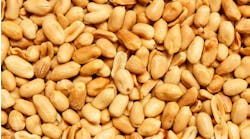Nuts have long enjoyed a solid reputation among food processors because of their nutrition content, taste and texture. But this year the category got a remarkable boost from USDA: The agency’s Agricultural Research Service announced that new research found that whole nuts contribute less calories than previously thought.
“Nuts remain a nutrient-dense snack, but the number of calories provided in a single serving has been grossly miscalculated,” said David Baer, a USDA researcher, when the new figures were released. “Our findings suggest a more accurate representation of calories, and food companies using nuts in their products will be able to provide clearer information to the public.”
That announcement boosted companies that make nut-rich foods – such as Kind snacks, which quickly changed their nutrient labels to reflect the improvement – and confirmed what nut advocates have always put forth: that the crunchy little foodstuffs, as well as seeds and legumes, play an important role in a healthy diet.
“Traditional nuts and seeds are naturally high in fat, fiber, and protein and low in carbohydrates, which make them perfect foods/ingredients for today’s consumer,” says Amy Usiak, business partner-product development at food industry consulting firm JPG Resources. “Nuts and seeds are gluten-free, grain-free, keto and paleo-friendly, so all formats are a go-to tool in developing products to fit these needs.”
Almonds: Beyond the crunch
Almonds are among the most popular nuts used in food formulating. They’re found in everything from candy bars to baked goods to bagged salad kits. According to a 2019 study by Innova Market Insights, 46% of products introduced in North America that contained nuts in 2018 included almonds.
It’s the almond’s “crunch factor” that drives much of its popularity, but those nuts also provide a valuable nutritional boost to processed food and are often found in “good-for-you” products that are gluten-free and dairy-free.
“Compared to other tree nuts, almonds contain the most protein (6g) and fiber (4g) per ounce,” notes Laura Gerhard, director of strategy and marketing in the Global Ingredients Division of Blue Diamond Almonds. “They are an excellent source of vitamin E and magnesium and a good source of calcium, riboflavin, potassium and phosphorous. Almonds also boast a heart-healthy fat profile, with 13g of ‘good’ unsaturated fat and only 1g of saturated fat in every ounce.”
The most common applications of almonds are snacks, cereal and baked goods. However, other applications are on the rise: The Innova study showed steady growth in categories such as desserts and ice cream (+10 percent in 2018 over 2017), dairy (+13 percent), spreads (+29 percent) and sports nutrition (+95 percent).
“At Blue Diamond, we certainly see these trends playing out with our own manufacturing partners, who are formulating with almonds in a variety of forms,” Gerhard says. “In particular, we see the continued potential for almonds in sports nutrition products – such as bars, mixes and beverages – as consumers look for more natural sources of fuel and nutrition throughout their day.”
Almond milk – made by grinding almonds in water – is another favorite application in food processing. The milk is naturally rich in vitamin E and other nutrients and is frequently used to create a smooth or creamy texture in sauces, dips, spreads and desserts. For example, Kite Hill makes a line of dips that use almond milk as the principle ingredient. The dips are available in Ranch and French Onion varieties.
“Almond milk has become a more commonly used form in product development over the past few years as the trend toward dairy alternatives has taken off,” says Harbinder Maan, associate director of trade marketing and stewardship at the Almond Board of California. “Almond milk allows for dairy- and lactose-free product development and is a versatile option for carrying trending flavors in bottled drinks, smoothies and cold-pressed juices.”
Another form of almond that is growing in application is almond butter. Almond butter is simply ground almonds, with a texture similar to peanut butter (but suitable for people with peanut allergies).
Maan explains that almond butter is sometimes used as a standalone dip or spread, but also is used as a binder in cookies and other baked goods. “It can also be used as a thickener in beverages and smoothies to customize texture for varying preferences,” she adds.
Powdered forms of almond – including flour, defatted flour and protein powder – are used in numerous processed foods. For example, defatted almond flour has an extra-fine texture and clean taste that makes it ideal as a binder or density-enhancer in bars, Maan explains.
Gerhard sees a lot of promise in her company’s protein powder. “Blue Diamond Almond Protein Powder – our latest almond innovation – fulfills against many prominent ingredient trends as a clean-tasting, plant-based protein source. The ingredient is ideal for a variety of food and beverage products, including nutrition, snack and cereal bars as well as protein shakes and smoothies.”
Walnuts: From snacks to Meat Alternatives
Another tree nut on the rise is the walnut, which can be found in applications as diverse as snack bars and meat alternatives.
Like almonds, walnuts pack a nutritional punch. Among their nutrients is omega-3 alpha-linolenic acid, an essential fatty acid that humans cannot produce in their own bodies.
“Walnuts are the only nut that provide a significant amount of plant-based omega-3 alpha-linolenic acid, with 2.5g per ounce,” notes Jennifer Williams, marketing director of the California Walnut Board and Commission.
“Walnuts are unique among nuts as they are primarily comprised of polyunsaturated fatty acids, whereas most other nuts contain mostly monounsaturated fats,” she continues. “One ounce of walnuts also contains 4g of protein, 2g of fiber and is a good source of magnesium and phosphorus.”
Williams says walnuts have grown as an ingredient in bars for several reasons, including texture and taste. They have a medium bite feel that makes them ideal as a binder in nut-dense bars, and the subtle nut flavor complements chocolate, vanilla and fruit flavors in those bars, she explains.
Walnuts also play a role in snacks such as nut mixes. The interesting, convoluted shape of an intact walnut gives it a special place in those mixes.
“Its natural contours create a dynamic eating experience when seasonings are used,” Williams explains. “On the market, we’re seeing a host of seasonings used in walnuts ranging from rosemary to espresso to pumpkin spice. Seasoned walnuts have proven the perfect heart healthy snack.”
One of the more interesting uses of walnuts today, however, is in alternative meat products.
“When combined with black beans or chickpeas, walnuts have an uncanny ability to mimic the texture of ground beef,” Williams says. “Just add any seasoning and you have the perfect meat-alternative in frozen burritos, lasagnas and more.”
Among the commercial meat-alternative products using walnuts are Amy’s Organic California Veggie Burger – which is made with walnuts, bulgur wheat, mushrooms and vegetables – and Eat Nice Meaty Walnut Ravioli, which mimics meat with a combination of walnuts, cashews, sundried tomatoes and seasonings.
Sunflower seeds
Sunflower kernels, like tree nuts, have found growing applications in food processing because of their desirable nutritional profile. They are high in dietary fiber, folate, zinc and vitamin E, among other nutrients.
Sunflower kernels are finding sudden new demand in applications calling for high-protein, low-carbohydrate ingredients.
“Seed proteins – such as from chia, pumpkin, hemp, flax and sunflower – are on the rise,” says Usiak of JPG Resources. “Seeds are naturally higher in protein than nuts and legumes.”
A quarter-cup of sunflower kernels contains 5.8g of protein, 3.9g of fiber and 7g of carbohydrates. And because the sugar content of sunflower kernels is very low, they are considered a low-glycemic food.
“Low carbohydrate foods are great for people looking to lose weight or deal with diabetes, and foods made with sunflower fit very well with that,” says John Sandbakken, executive director of the National Sunflower Assn.
Sunflower butter – which is simply kernels ground into paste – has the same nutritional benefits as whole kernels and is used in many applications in place of peanut butter.
“The demand for sunflower butter is high in schools, because they’re concerned about peanut allergies,” Sandbakken notes. “It’s a good alternative for folks allergic to peanuts or soy products.”
Sunflower butter is found in many desserts, such as cookies and other baked goods. Ben & Jerry’s includes sunflower butter in three recent flavors: Milk and Cookies, Crème Brulee Cookie, and Mint Chocolate Cookie.
SunButter is a major supplier of sunflower butter to food manufacturers. “Natural, simple, delicious SunButter is an excellent peanut-free, tree nut-free alternative to peanut butter in many products and formulations,” the company states on its web site. “SunButter comes in many varieties, from natural to natural crunch to unsweetened organic.”
And of course straight up sunflower seeds in shells are a popular snack. Makers of in-shell seed snacks, such as David and Bigs, have partnered with other well-known consumer brands to expand the category. Consumers can now snack on varieties ranging from Frank’s Red Hot to Vlasic Pickle to Jack Daniel’s.
Other nuts and seeds
Naturally, nuts and seeds used in food processing are not limited to the three highlighted above. Other important products in the category include pumpkin seeds – pumpkin seed flower is often used in breads, cakes and healthy snacks, for example – pistachios, pecans and hazelnuts. And of course, peanuts -- which are actually legumes, not nuts – are used in intact and butter form in thousands of applications.
The bottom line is that nuts, seeds and legumes are essential to many food processing applications and will likely continue growing in importance.
Says Usiak: “With increasing focus on both the nutrition of nuts, seeds and legumes; their forms or formats; and the different allergens they may or may not have, we are seeing a rise in the use of all these nuts across product lines and categories.”


